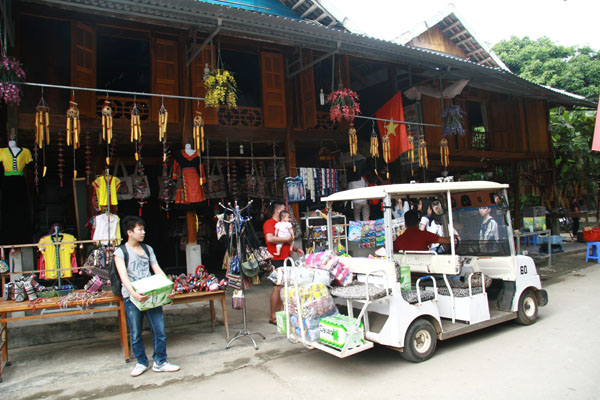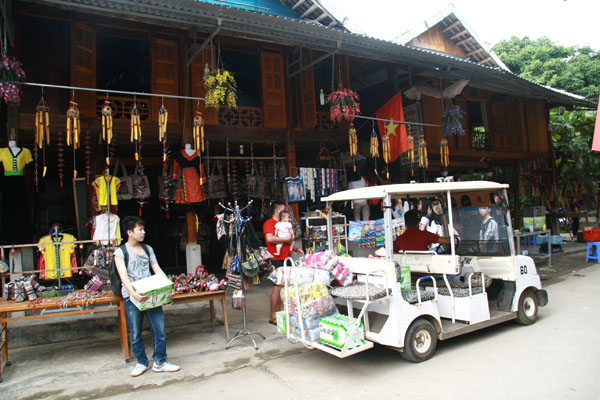
(HBO) – About 60km northwest of Hoa Binh city, Lac village of Chieng Chau commune, Mai Chau district, is hidden among mountain ranges. It is a popular destination, especially among those who passion natural beauty and ethnic minority culture.
Foreigners tour Lac village by bicycle
Lac village is situated in Mai Chau valley and is home to Thai ethnic people.
Once here the peace and picturesque that nature has given to this place become
apparent. In the past, locals depended on farming rice and making brocades for
a livelihood. However, the village’s hidden charm has recently been explored,
particularly through increasing community-based tourism, helping turn it into a
key tourism site of Mai Chau and the northwestern region.
The number of tourists to Lac village has risen in recent years. Stilt houses
have been upgraded but still have traditional features, while 57 houses provide
homestay services in the village at present. More than 12,880 tourists,
including about 2,950 foreigners, enjoyed the services in 2016. Service quality
is improving and foreigners are not overcharged as all service prices are
publicised. Tourists in groups can rent a stilt house at 500,000 – 1 million
VND (22 – 44 USD) while single travellers can rent a room at 200,000 VND (8.8
USD).
Lang Cam Van, a student of the University of Industry, said her group with more
than 50 members rented two houses at 750,000 VND (33 USD) each. The houses were
clean while the host was very friendly, making them feel at home.
Foreign visitors enjoy coming here. They can eat traditional dishes of Thai
ethnic people such as "ga doi” (free-range chicken), "mang dang” (bitter bamboo
shoot), "ruou can” (wine drunk out of a jar by pipes), and "nep nuong” (sticky rice
grown in hills). Daniel, a tourist from
New Zealand, said: "I love the food
here, especially "com lam” (bamboo-tube rice). This is the first time I seen
rice is cooked in a special way. The sticky rice in combination with coconut
and the typical fragrance of bamboo tubes create a perfect dish. We are not
confused by the language because local people could communicate in English
fluently. We also had a brocade weaving experience and joined art performances.
We made a lot of unforgettable memories in this place.”
Head of the Lac hamlet Ha Cong Hong said tourism is the main source of income
for locals at present. The previous year’s average per capita income was
estimated at 27 million VND. We are always aware of improving service quality
to attract visitors. Social order and security are ensured. We plan to build a
tourism development project and create flower gardens for visitors to take
photos.
According to Hong, locals understand that a good environment will boost
community-based tourism. Households clean the streets and dredge the sewers.
However, there are no effective measures to treat waste, with most rubbish
burnt. Local communes have encouraged families to contribute money to hire an
environment company to collect garbage.
Dong Huong
With an increasingly vibrant and widespread emulation movement aimed at building cultured residential areas and cultured families, Yen Thuy District has been making steady progress toward improving both the material and spiritual well-being of its people, while fostering a civilized, prosperous, beautiful, and progressive community.
Once lacking recreational spaces and community facilities, Residential Group 2 in Quynh Lam Ward (Hoa Binh City) has recently received attention for the construction of a new, spacious, and fully equipped cultural house. The project followed the model of state support combined with public contributions in both labor and funding.
The "All people unite to build cultural life" movement, which has been effectively integrated with Kim Boi district’s socio-economic development goals, is fostering a lively spirit of emulation across local residential areas, hamlets, villages, public agencies, and enterprises. In addition, through the initiative, traditional cultural values are being preserved and promoted, while community solidarity and mutual support in poverty reduction and economic development are being strengthened.
A working delegation of the Hoa Binh provincial People’s Committee led by its Permanent Vice Chairman Nguyen Van Toan on June 11 inspected the progress of a project to build the Mo Muong Cultural Heritage Conservation Space linked to tourism services in Hop Phong commune, Cao Phong district.
Born and growing in the heroic land of Muong Dong, Dinh Thi Kieu Dung, a resident in Bo town of Kim Boi district, in her childhood was nurtured by the sweet lullabies of her grandmother and mother. These melodies deeply imprinted on her soul, becoming an inseparable part of her love for her ethnic group's culture. For over 20 years, this love for her hometown has driven Dung to research, collect, and pass down the cultural values of the Muong people to future generations.
In the final days of May, the Ethnic Art Troupe of Hoa Binh Province organized performances to serve the people in remote, mountainous, and particularly disadvantaged areas within the province. These were not just ordinary artistic shows, but they were the meaningful journeys aimed at spreading cultural values, enhancing the spiritual life of the people and contributing to the preservation of ethnic minority cultural identities.


